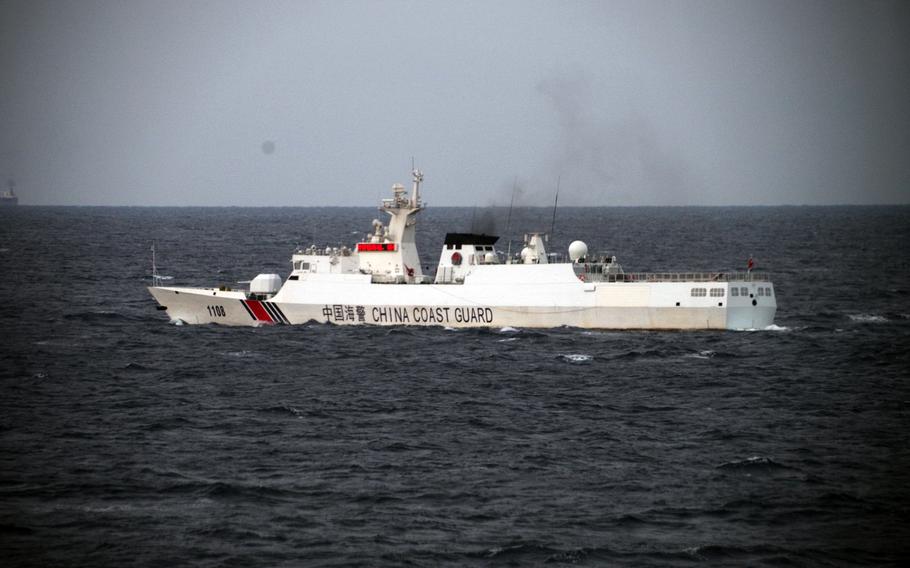
China coast guard vessel 1108 appears to be armed with a deck-mounted machine gun as it steams near the Senkaku Islands, May 1, 2023. (Japan coast guard)
Tokyo lodged another round of diplomatic protests with Beijing on Thursday over intrusions around Japan-controlled islands in the East China Sea, according to Japan’s Foreign Affairs Ministry.
The latest incident marked the 13th time this year that Chinese vessels have passed the 12-mile territorial limit around the Senkaku chain, a small but potentially significant flashpoint approximately halfway between Okinawa and mainland China.
Two Chinese coast guard ships passed the 12-mile limit between 2:56 a.m. and 3:32 a.m. Thursday and remained there into the afternoon, a Japan coast guard spokesman told Stars and Stripes by phone that day.
Japan’s Foreign Affairs Ministry lodged complaints Thursday with the Chinese Embassy in Japan and with the Chinese government in Beijing, a ministry spokesman told Stars and Stripes by phone that day.
“We asked them to leave the area,” the spokesman said. Some government officials in Japan are required to speak to the media only on condition of anonymity.
The Senkakus — five uninhabited islets and three rocks 105 miles east of Taiwan — are administered by Japan but claimed by China and Taiwan, who refer to them as the Diaoyu and Tiaoyutai, respectively. The area reportedly holds a wealth of natural resources, including fish, oil and natural gas.
The first Chinese coast guard ship passed the territorial limit southeast of Minamikojima, followed by a second vessel south of Uotsurijima, the coast guard spokesman said. Both were trailing Japanese fishing boats.
The Chinese ships were met by a larger contingent of Japanese coast guard vessels, the spokesman said. The Japanese ships positioned themselves between the fishing boats and the Chinese vessels and warned the Chinese by radio and electronic message boards to leave the area.
Chinese ships came within 12 miles of the Senakus 28 times and remained for a total of 37 days in 2022, the spokesman said. The record is 2013, when Chinese vessels entered the territorial limits 52 times and remained there for 54 days.
China is increasingly aggressive in asserting its claims or harassing its neighbors in the East and South China Seas, vital waterways where an estimated $1.2 trillion in global trade passes each year.
In February, Manila accused Beijing of temporarily blinding crew members on a Philippine coast guard vessel with a “military-grade” laser during a South China Sea resupply mission, Reuters reported on Feb. 13.
On April 23, a Chinese coast guard vessel blocked a Philippine patrol ship near the disputed Second Thomas Shoal, 105 nautical miles west of Palawan, the Philippines. The two nearly collided, according to The Associated Press.
The U.S. and Philippine governments in February announced plans to resume later this year joint patrols in the South China Sea that were suspended in 2016.
Vietnam complained in April 2020 after a Chinese maritime surveillance vessel rammed and sank one of its fishing boats with eight crew members aboard near the Paracel Islands, another disputed chain in the South China Sea.
The U.S. Defense Department condemned the incident in a statement April 9. China’s behavior, the statement said, “stands in contrast to the United States' vision of a free and open Indo-Pacific region, in which all nations, large and small, are secure in their sovereignty, free from coercion, and able to pursue economic growth consistent with accepted international rules and norms.”